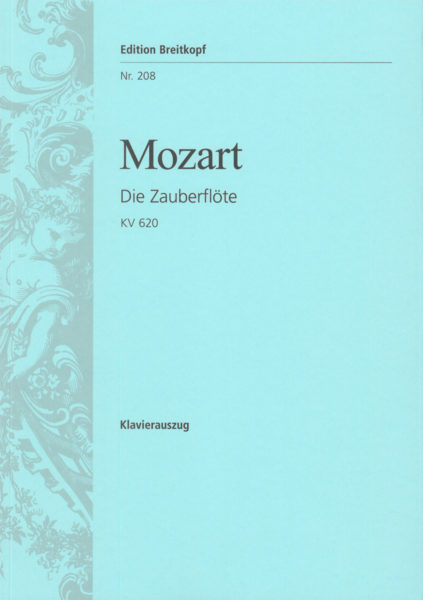Wolfgang Amadeus Mozart (1756–1791) Die Zauberflöte KV 620
Deutsche Oper in 2 Akten Text: Emanuel Schikaneder
Soli: 7S (davon 2 Knaben). A (Knabe). 3T. Bar. 3B – 3Spr – Chor: SATTBB – 2(Picc)2.2.2Bassetthn.2 – 2.2.3.0 – Pk.Schl – Str / BM: Fl
Nachdem Sie die gewünschten Ausgaben in den Warenkorb gelegt haben, können Sie dort die benötigte Stückzahl bei Bedarf noch anpassen.
AD: abendfüllend
Libretto: Emanuel Schikaneder
Ort: Ägypten
Personen: Sarastro (Bass) - Tamino (Tenor) - Sprecher (Bass) - 1. Priester (Sprechrolle) - 2. Priester (Tenor) - 3. Priester (Sprechrolle) - Königin der Nacht (Sopran) - Pamina (Sopran) - 1. Dame der Königin (Sopran) - 2. Dame der Königin (Sopran) - 3. Dame der Königin (Alt) - 1. Knabe (Sopran: Knabenstimme) - 2. Knabe (Sopran: Knabenstimme) - 3. Knabe (Alt: Knabenstimme) - Papageno (Bariton) - Papagena (Sopran) - Monostatos (Tenor) - 1. Geharnischter Mann (Tenor) - 2. Geharnischter Mann (Bass) - 3 Sklaven (Sprechrollen)
Ballett: Mohrentanz
Nur gieng ich auf das theater bey der Arie des Papageno mit dem Glocken-Spiel, weil ich heute so einen trieb fühlte es selbst zu Spielen. - da machte ich nun den Spass, wie Schickaneder einmal eine haltung hat, so machte ich eine Arpegio - der erschrack - schauete in die Scene und sah mich - als es das 2:te mal kamm - machte ich es nicht - nun hielte er und wollte gar nicht mehr weiter - ich errieth seinen Gedanken und machte wieder einen Accord - dann schlug er aufs Glöckchenspiel und sagte halts Maul - alles lachte dann - ich glaube Dass viele durch diesen Spass das erstemal erfuhren Dass er das Instrument nicht selbst schlägt. (Brief Mozarts an seine Frau Constanze).
Unerhört, was der Revuedirektor Schikaneder so alles kannte und von weither zusammengoss: Kasperle und Prinzenzier, Ausstattungsstücke, die man überbieten wollte, ägyptisierende Überlieferungen von Plutarch, ja von Herodot und Platon, bis zur Renaissance und in die Aufklärung, Wielands Märchen 'Lulu und die Zauberflöte', samt der Wasser- und Feuerprobe aus seinem 'Stein der Weisen', Volksposse und Maurertum, das dann der höchste Effekt ward, kurz alles, was gut und teuer, auch was gut und nicht teuer war. Eigentümlich populär bot sich dazu Ägypten an, dessen Priester seit alters her eben im Geruch standen, zauberkundig wie keine anderen zu sein, und die im Ruf standen, sich mit Recht tiefer Weisheit zu berühmen. Das gab der Szenen auch zweifellos etwas Aura aus dem Volksbuch vom Doktor Faust, ..."
Mit dieser Vielfalt der Motive und Stoffkreise, die Ernst Bloch 1930 in seiner Studie „Die Zauberflöte und Symbole von heute" so prägnant rekapituliert, aber auch mit dem ungewöhnlichen Reichtum der musikalischen Darstellungsmöglichkeiten, die in allen Abstufungen zwischen Opera seria und volkstümlichem Liederspiel eingesetzt sind, fordert Mozarts Oper seit ihrer Uraufführung am 30. September 1791 im „Theater an der Wieden" Auslegungen und Interpretationen geradezu heraus. Hatte Emanuel Schikaneders erste „Zauberflöte" als Sensationsstück gewirkt, das wegen seiner schaustellerischen Attraktivität das Publikum in Scharen anlockte und in den Folgejahren Anlag zu Nachahmungen, Fortsetzungen und Parodien gab, erfuhr das Werk noch in der ersten Hälfte des 19. Jahrhunderts eine grundsätzliche Neubewertung. Mit der Besinnung auf eine nationale deutsche Opernkultur bildete die „Zauberflöte" - und nicht die „Entführung aus dem Serail" - in der Rückschau den Ausgangspunkt jener zunächst nur spärlich repräsentierten Entwicklung, die über Beethovens „Fidelio" und Webers „Freischütz" in Wagners Musikdrama ihr vorläufiges Ziel erreichte. Mit der Forderung Wagners nach einer ganzheitlichen Konzeption des Musiktheaters (Gesamtkunstwerk), die für die Opernästhetik bis ins 20. Jahrhundert hinein maßgeblich blieb, mehren sich die Versuche, die „Zauberflöte" als einheitlich angelegtes Werk zu verstehen. Ausgehend von den auffälligen motivisch-thematischen Zusammenhängen in der Partitur liegt es nahe, Konsequenzen für die Dramaturgie zu ziehen und die polarisierenden Handlungselemente (Sonne/Mond, Mann/Frau, Selbstbeherrschung/Triebhaftigkeit) in eine übergeordnete, hermetisch geschlossene Bühnenwelt zu verlegen, deren allegorische Repräsentanten (Damen, Knaben, Tiere) sich dann durchaus zwischen Gut und Böse bewegen dürfen, ohne unglaubhaft zu wirken. Auf der anderen Seite erfährt das Werk szenische Interpretationen, die die heterogenen Bestandteile nicht in einem übergreifenden Konzept zusammenführen wollen. Möglicherweise liegt gerade in den letztlich nicht schlüssig interpretier- und darstellbaren Zusammenhängen ein wesentlicher Grund für die Kraft und Aktualität der „Zauberflöte" bis in unsere Tage. Die vorliegende Ausgabe stellt eine durchgreifende Revision des 1871 bei Breitkopf & Härtel erschienenen Klavierauszuges von Carl Friedrich Wittmann dar. Insbesondere die Dialoge wurden einer eingehenden Durchsicht unterzogen und folgen nun dem originalen Textbuch Schikaneders. Die häufig bei Aufführungen gestrichenen Dialogpartien sind dabei in eckigen Klammern angegeben.
Auf ein Detailproblem sei gesondert hingewiesen: Mozarts autographe Partitur, das Textbuch von 1791 und der Theaterzettel der Uraufführung machen widersprüchliche Angaben zur Besetzung der „Priester"-Partien im ersten Finale und im Duett (Nr. 11). Die heutige Bühnenpraxis kommt häufig mit zwei Gesangssolisten aus. Der Priester im ersten Finale wäre demnach vom Sprecher zu singen. Bei der Aufteilung in Nr. 11 trägt die vorliegende Ausgabe der Bühnenpraxis Rechnung.
Die meist sehr knappen Regieanweisungen des Originals wurden gelegentlich ergänzt oder behutsam modernisiert. Diese Abweichungen sind durch Kursivschrift kenntlich gemacht.









